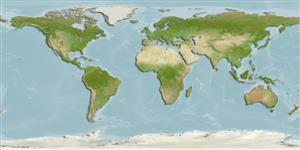كاملات الرؤوس (chimaeras) >
Chimaeriformes (Chimaeras) >
Chimaeridae (Shortnose chimaeras or ratfishes)
Etymology: Chimaera: Named for the mythological creature composed of parts of multiple animals, referring to their odd mix of characteristics. (See ETYFish); carophila: Named for Carol and Phil Kemper (caro + phil), supporters of chimaeroid research (and the senior author’s parents). (See ETYFish).
Environment: milieu / climate zone / depth range / distribution range
البيئة
بحري قاعية المعيشة; نطاق العمق 846 - 1350 m (Ref. 107024), usually ? - 1000 m (Ref. 107024). Deep-water; 32°S - 49°S, 166°E - 171°W (Ref. 107024)
Southwest Pacific: deep water slopes and plateaus surrounding New Zealand (Challenger Plateau, Chatham Slope and Rise, Hikurangi Trench, Campbell Plateau,
Bounty Plateau).
الحجم / وزن / العمر
Maturity: Lm ? range ? - ? cm
Max length : 104 cm TL ذكر/ مختلط الجنس; (Ref. 107024); 97.5 cm TL (female); أعلا وزن تم نشرة: 4.8 kg (Ref. 122636)
وصف مختصر
مفاتيح التعريف | الوصف الخارجي | قياسات المظهر الخارجي
This species is distinguished by the following characters: a short, blunt snout and an anal fin separate from the ventral caudal margin by a notch; medium-bodied with a gently rounded snout; large eye; oral and preopercular lateral line canals usually share a short common branch off of the infraorbital canal; relatively short first dorsal fin and spine; second dorsal fin even along height, long caudal dorsal and ventral margins, short, trifurcate pelvic claspers, divided distally for approximately one-third of their length; body colour uniform pale-brown, mouth and ventral snout darker with brownish-purple fins and highly deciduous skin. Distinguished from its closest congeners, Chimaera fulva, C. macrospina, and C. obscura, by a combination of morphological characters (longer caudal dorsal margin, shorter pelvic claspers, shorter dorsal fin spine, shorter first dorsal fin, and longer caudal ventral margin) and coloration (Ref. 107024).
The depth range of occurrence of this species seems to follow the 1000 m depth contour around New Zealand, but may be an artifact of sampling. Size range for juvenile females 27.7-75.9 cm TL (18.2-37.6 body length) and males 41.0-83.5 cm TL (16.7-52.2 cm BDL); for adult females 85.5-103.5 cm TL (51.9-59.9 cm BDL) and males 74.0-97.5 cm TL (48.7-57.0 cm BDL) (Ref. 107024).
Life cycle and mating behavior
Maturities | التكاثر | Spawnings | Egg(s) | Fecundities | Larvae
Kemper, J.M., D.A. Ebert, G.J.P. Naylor and D.A. Didier, 2015. Chimaera carophila (Chondrichthyes: Chimaeriformes: Chimaeridae), a new species of chimaera from New Zealand. Bull Mar Sci. 91(1):63-81. (Ref. 107024)
IUCN Red List Status (Ref. 130435)
استخدامات بشرية
أدوات
تقارير خاصة
Download XML
مصادر علي الأنترنت
Estimates based on models
Phylogenetic diversity index (Ref.
82804): PD
50 = 0.5000 [Uniqueness, from 0.5 = low to 2.0 = high].
Bayesian length-weight: a=0.01000 (0.00244 - 0.04107), b=3.04 (2.81 - 3.27), in cm total length, based on all LWR estimates for this body shape (Ref.
93245).
مستوى غذائي (Ref.
69278): 3.7 ±0.6 se; based on size and trophs of closest relatives
المرونه (Ref.
120179): منخفظ جدا, الحد الزمني الأدني لتضاعف عدد أفراد المجتمع أكثر من 14 سنة (Preliminary K or Fecundity.).
Fishing Vulnerability (Ref.
59153): High vulnerability (62 of 100).
